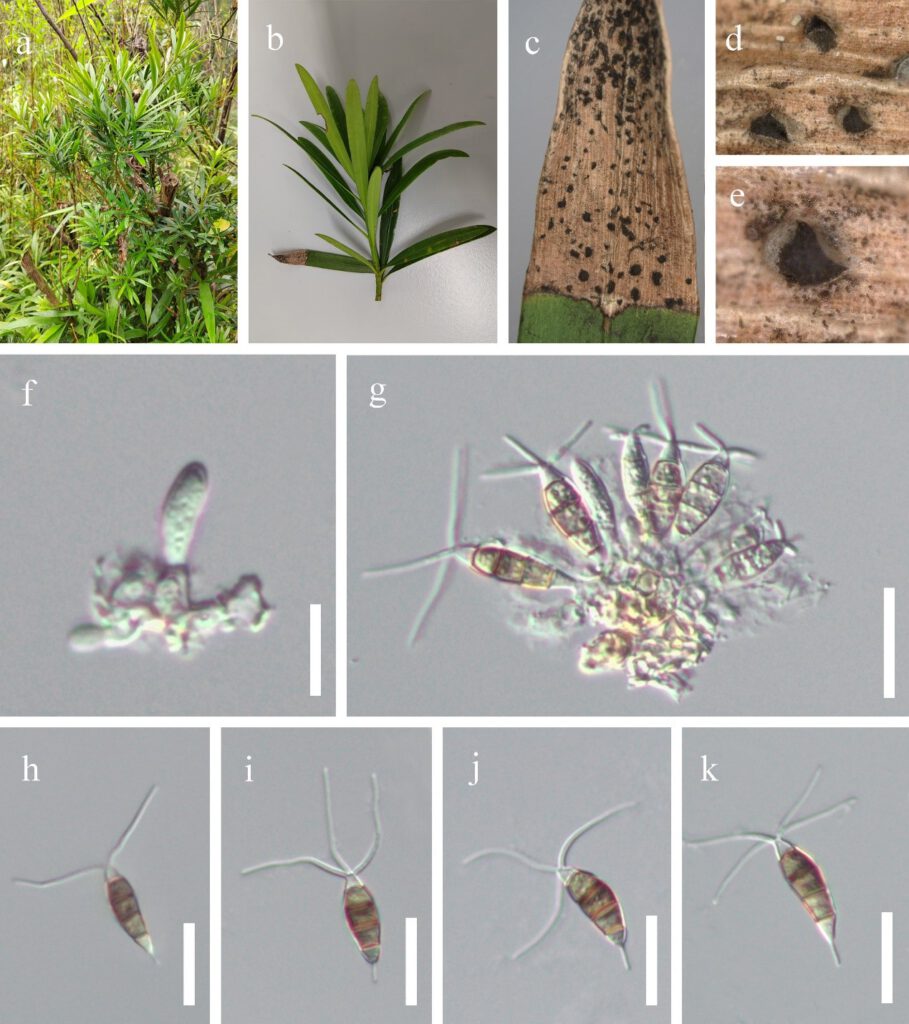Neopestalotiopsis rhapidis Qi Yang & Yong Wang bis, Biodiversity Data Journal 9(no. e70446): 9 (2021) Fig. 9
Index Fungorum number: IF 840065; MycoBank number: MB 840065; Facesoffungi number: FoF 12917;
Associated with leaf spot on leaves tip of Podocarpus macrophyllus. Symptoms irregular shape, brown, dry, slightly sunken on leaves tip. Sexual morph: Not observed. Asexual morph: Conidiomata solitary, subglobose to globose, unilocular, dark brown to dark, semi-immersed on leaves. Conidiophores indistinct, often reduced to conidiogenous cells. Conidiogenous cells subcylindrical or ampulliform, short, hyaline. Conidia 17.5–25.0 × 5.0–8.0μm, ±SD = 22.0±1.4 × 6.5±0.7 μm (n = 40), L/W ratio = 3.4, fusiform, straight to slightly curved, 4-septate; basal cell obconic with a truncate base, hyaline, 3.0–6.2 μm long ( ± SD = 4.3 ± 0.65 μm); three median cells doliiform to cylindrical, 11.5–17.0 μm long ( ± SD = 14.5 ± 1.0 μm), pale to brown, versicolourous, septa darker than the rest of the cell; second cell from base pale to brown, 3.0–6.0 μm long ( ± SD = 4.5 ± 0.65 μm); third cell pale to brown, 3.3–6.5 μm long ( ± SD = 5.0 ± 0.6 μm); fourth cell pale to brown, 2.5–5.5 μm long ( ± SD = 4.2 ± 0.7 μm); apical cell 2.0–5.0 μm long ( ± SD = 3.0 ± 0.6 μm), hyaline, conic to acute; with 2–4 (mostly 3) tubular appendages on apical cell, inserted at different loci in a crest at the apex of the apical cell, unbranched, 12.0–28.0 μm long ( ± SD = 20.5 ± 3.4 μm); single basal appendage, unbranched, tubular, centric, 2.5–7.0 μm long ( ± SD = 4.8 ± 1.2 μm).
Culture characteristics – Conidia germinated on PDA within 12 hours at 25 ℃ from single-spore isolation. Apical cells produced germ tubes. Colony diameter reached 80 mm after 7 days at 25 ℃ on PDA media, circular, surface rough, flat, white from above, yellow from below.
Material examined – China, Guizhou Province, Qiannan Buyi and Miao Autonomous Prefecture, Libo District, leaf spots of Podocarpus macrophyllus (Thunb.) D. Don (Podocarpaceae), 12 March 2022, Y.R. Sun, ML3 (HKAS 124559); living cultures, GUCC 806.
Notes – Neopestalotiopsis rhapidis was introduced by Yang et al. (2021) from leaf spot of Rhapis excelsa (Arecaceae) in China. Our isolate GUCC 806 clustered together with N. rhapidis (GUCC 21501) in the phylogenetic tree. These two species have overlapping conidial measurements (17.5–25.0 × 5.0–8.0 μm for GUCC 806 vs. (22–)25.5 × 4(–6) µm for GUCC 21501) (Yang et al. 2021). Both isolates were associated with leaf spots in China. Therefore, we identify GUCC 806 and GUCC 21501 to be conspecific species, and GUCC 806 represents a new host record.

Figure 9 – Neopestalotiopsis rhapidis (MFLU 22-0XXX, new host record). a, b Host. c Leaf blight on Podocarpus macrophyllus. d, e Close up view of conidiomata. f, g Conidia attached to conidiogenous cells. h–k Conidia. Scale bars: f = 10 µm, g–k = 20 µm.
